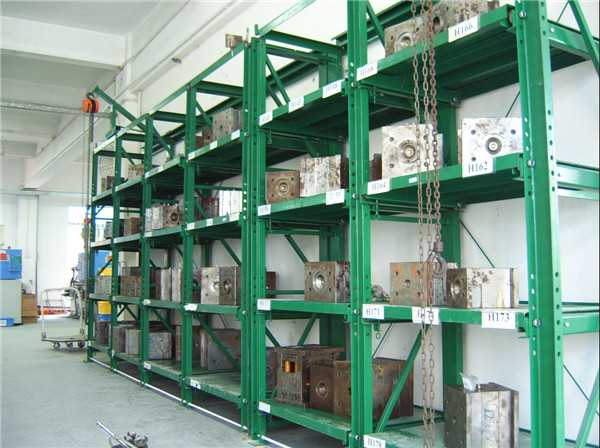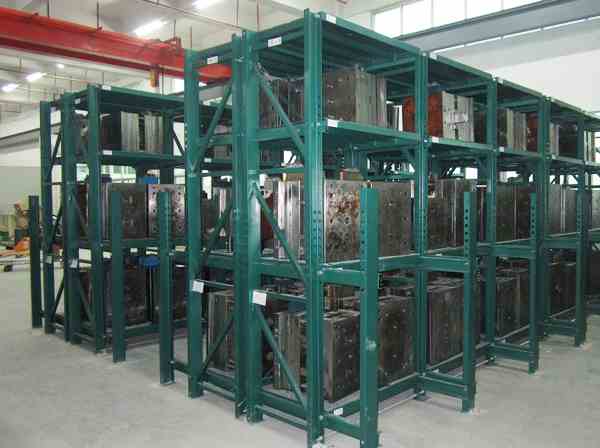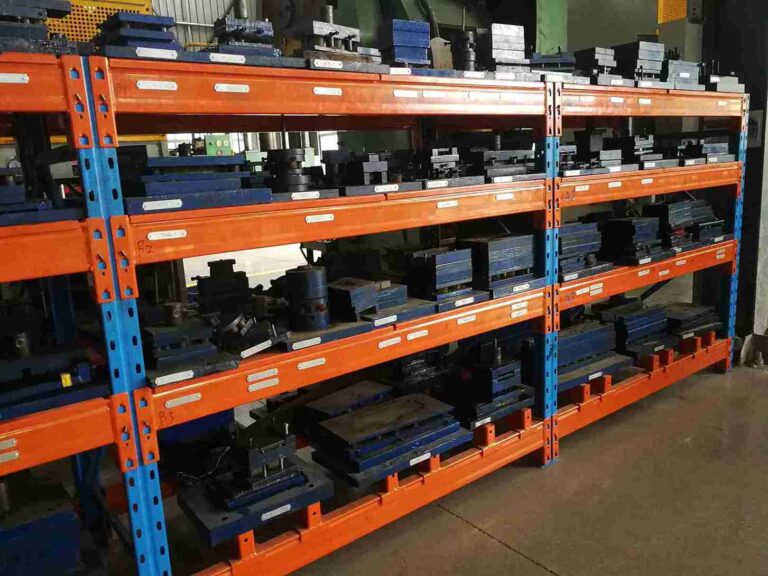📐 "First 50 Enterprise Queries Get Custom 3D Warehouse Design" Plan

In the high-stakes environment of manufacturing, the manner in which a facility manages its mold rack storage is a definitive indicator of its overall operational excellence. Molds, dies, and fixtures are not merely tools; they are the heart of production, representing immense capital investment and the very source of revenue. Inadequate mold rack storage solutions lead to a domino effect of catastrophic problems: devastating asset damage from improper support, severe workplace injuries, debilitating production delays during retrieval, and the exorbitant waste of prime manufacturing floor space.
This authoritative guide, synthesizing decades of engineering and global installation experience, presents a comprehensive framework for transforming mold rack storage from a necessary evil into a formidable competitive advantage. We will dissect the precise engineering specifications that separate true heavy-duty mold rack storage from inadequate imitations, explore the revolutionary potential of automated retrieval systems, and provide a actionable blueprint for designing a mold rack storage solution that delivers unparalleled safety, maximizes spatial efficiency, and protects critical production assets. The objective is to empower you with the knowledge to critically assess your current mold rack storage paradigm, understand the highest industry standards, and make an informed decision that directly impacts your bottom line.

The Critical Role of Specialized Mold Rack Storage in Modern Manufacturing
The challenges of mold rack storage are unique in the world of industrial logistics. Unlike uniform pallets, molds are characterized by immense weight, asymmetrical shapes, and incredibly precise—and easily damaged—finishes. Standard warehouse shelving or generic pallet racking is engineered for distributed loads and simply cannot withstand the extreme point loads exerted by a multi-ton mold resting on a few small feet. This fundamental mismatch is the root cause of most mold rack storage failures.
A professional mold rack storage system is designed from the ground up to address these specific challenges. It is a engineered solution that accounts for:
- Extreme Point Loads: The entire structure is calculated to support immense weight concentrated on very small surface areas, a non-issue for standard storage but the paramount concern for mold rack storage.
Asset Protection: The support surfaces are designed to prevent denting, warping, or scratching the mold’s critical base. This is a primary function of any high-quality mold rack storage system.
Dynamic Forces: A robust mold rack storage system must resist the constant stresses of forklift or overhead crane interactions, seismic activity, and the impact of loading and unloading. This requires a holistic engineering approach, not just heavier steel.
Investing in a purpose-built mold rack storage system is, therefore, an investment in risk mitigation. It directly protects against the astronomical costs of mold repair or replacement and the existential threat of production downtime.
Heavy-Duty Defined: The Engineering Principles of Superior Mold Rack Storage
The term “heavy-duty” is often used generically. In the context of mold rack storage, it has a precise, mathematical meaning. Understanding these engineering principles is crucial for selecting a system that guarantees long-term safety and performance.
The Critical Distinction: UDL vs. Point Load Ratings
This is the most important concept in mold rack storage.
- Uniformly Distributed Load (UDL): This is the standard rating for most warehouse racking. A beam with a 4,000 lbs UDL rating can support that weight if it is spread evenly across its entire length.
Point Load Capacity: This is the rating that matters for mold rack storage. It specifies the maximum weight that can be applied to a single, concentrated point on the beam. A true heavy-duty mold rack storage beam will have a point load rating of 8,000 lbs, 10,000 lbs, or higher, often achieved through custom steel profiles and internal reinforcing.
Deconstructing the Components of a Industrial-Grade Mold Rack Storage System
- Beam Engineering: Superior mold rack storage systems utilize hot-rolled steel beams with a minimum thickness of 7-gauge (0.1793″). The design often includes double-step beams or integrated V-Lok profiles that provide a positive lock and distribute weight over a wider area, frequently with replaceable urethane pads to protect mold surfaces.
Upright Frame Integrity: The uprights are the backbone of any mold rack storage array. Industrial-grade frames feature thicker-column steel (e.g., 10-gauge), wider profiles (6” or more), and increased perforations for robust bracing and anchoring.
Integrated Safety Locking: Every beam connection in a professional mold rack storage system must feature a positive locking mechanism—a pin, latch, or wedge—that prevents accidental dislodgement from lateral impacts.
The Non-Negotiable 3:1 Safety Factor: Reputable mold rack storage is engineered with a minimum safety factor of 3:1. This means a beam rated for a 10,000 lbs point load is designed to fail only under 30,000 lbs of force, providing a critical margin of safety.
The Inextricable Link Between Mold Rack Storage and Operational Safety
A poorly designed mold rack storage area is one of the most significant safety hazards in a manufacturing facility. The consequences of failure are severe. A professional system is the primary defense against these risks.
Mitigating Catastrophic Collapse and Impact Risks
The interaction between material handling equipment and storage structures creates inherent risk. A proper mold rack storage design incorporates specific features to manage this:
- Structural Column Guards: Heavy-gauge steel protectors bolt to the front of upright frames to absorb the energy from a forklift impact, preventing damage to the critical structural members of the mold rack storage system.
Aisle Width Calculation: Layouts are scientifically designed to provide optimized clearance for the specific equipment used, reducing the probability of a strike. This is a calculated design parameter for any new mold rack storage installation.
Elimination of Protrusions: The use of positive-locking beams and clean designs ensures there are no loose hooks or protruding elements that can snag on equipment or personnel.
Ergonomics: Reducing Musculoskeletal Injuries
The manual handling of heavy, awkward molds is a primary cause of debilitating worker injuries. An intelligently designed mold rack storage system is a fundamental ergonomic intervention.
- Strategic Height Planning: Beams are positioned to store molds at an optimal “golden zone” height (waist to chest level), drastically reducing awkward bending, reaching, or overhead lifting during setup.
Seamless Flow Integration: The mold rack storage layout is designed in concert with the paths of overhead cranes, jib cranes, or AGVs, creating a fluid workflow that allows mechanics to move tools directly from storage to the press with minimal manual handling.
Spatial Economics: Maximizing Value Through Advanced Mold Rack Storage Design
In industrial real estate, floor space is a direct cost center. Optimizing the density of your mold rack storage is a powerful lever for reducing overhead and freeing up space for revenue-generating activities.
The Power of Vertical Utilization: Reaching for the Cube
The most common oversight in mold rack storage is the underutilization of vertical space. Standard shelving occupies a fraction of the available cube. Professional mold rack storage solutions, such as high-rise cantilever systems or adapted pallet racking, allow facilities to build safely up to 30, 40, or even 50 feet, multiplying storage capacity on the same footprint.
Custom-Engineered Configurations for Real-World Challenges
Expert mold rack storage providers don’t sell pre-packaged kits; they engineer solutions for unique spatial and operational constraints.
- Narrow-Aisle Mold Rack Storage: By integrating with specialized narrow-aisle forklifts, aisle width can be reduced from 12+ feet to 8-9 feet, increasing storage density by over 30% within the same mold rack storage area.
Structural Mezzanine Integration: For facilities with high ceilings, a structural mezzanine can be constructed over a portion of the mold rack storage or vice-versa, effectively doubling the available floor space in a designated area.
High-Turnover Flow Rack Systems: For frequently used molds, a first-in, first-out (FIFO) flow rack system can be integrated into the mold rack storage plan. Molds are loaded on one side and roll forward to the pickup point on the other, minimizing search time and ensuring tooling rotation.
The Automation Revolution: Automated Mold Rack Storage and Retrieval Systems (ASRS)
For the ultimate expression of space optimization, security, and retrieval efficiency, Automated Storage and Retrieval Systems (ASRS) represent the pinnacle of mold rack storage technology.
Unit-Load ASRS for Mold Rack Storage
This system involves a fully automated, robotic shuttle or crane that operates within an ultra-high-density rack structure. It automatically stores and retrieves molds on pallets or shuttles, delivering them to a pick-up station. This form of automated mold rack storage can reduce the storage footprint by over 80% compared to floor storage, making it the most space-efficient mold rack storage solution available.
The Compelling ROI of Automated Mold Rack Storage
- Unrivaled Storage Density: The virtual elimination of aisles allows for an incredibly dense mold rack storage matrix, reclaiming vast amounts of floor space.
Perfect Digital Inventory: The software provides real-time, exact location data for every asset. The concept of a “lost mold” is eliminated. This automated mold rack storage software can often integrate directly with a facility’s CMMS or ERP system.
Enhanced Safety Profile: By removing personnel from the storage aisles and the operation of forklifts within the mold rack storage area, the risk of accidents is drastically reduced.
Dramatic Labor Efficiency: Retrieval times are slashed from minutes to seconds, freeing highly skilled technicians for productive tasks rather than search and retrieval operations.
A Framework for Success: The Professional Mold Rack Storage Design Process
Implementing a new mold rack storage system is a strategic project, not a simple procurement. It follows a meticulous phased approach.
Phase 1: Comprehensive Discovery and Audit
The foundation of a successful mold rack storage project is deep operational understanding.
- 1.Asset Inventory and Analysis: Every mold, die, and fixture is cataloged. Critical data includes weight, dimensions, footprint, center of gravity, and usage frequency.
- 2.Process Flow Mapping: The entire journey of a mold—from storage, to cleaning, to press, and back to storage—is diagrammed to identify bottlenecks and inefficiencies in the current mold rack storage workflow.
- 3.Facility Spatial Audit: Precise measurements of the facility are taken, noting all obstructions, column locations, doorways, clear ceiling heights, and the operational paths of all material handling equipment.
Phase 2: Precision Engineering and Design
Data informs design. Using the audit information, engineers create a tailored solution.
- 1.Conceptual Layout Development: Multiple mold rack storage layout options are generated, each balancing density, accessibility, workflow, and budget. These are presented in detailed 3D CAD models.
- 2.Structural Calculation and Validation: Every component is specified, and the entire mold rack storage design is validated through engineering software to meet all local building codes and safety standards, including seismic and wind load requirements where applicable.
- 3.Integration Strategy: The design includes a full plan for integrating with existing forklifts, cranes, and any automation (AGVs, ASRS).
Phase 3: Flawless Implementation and Installation
Precision installation is what brings a mold rack storage design to life safely and effectively.
- Certified Professional Installation: Certified teams ensure every upright is perfectly plumb, every beam is level and securely locked, and every anchor is torqued to the engineer’s specification. This is non-negotiable for the integrity of the mold rack storage system.
Labeling, Coding, and Digital Management: A comprehensive labeling system is implemented for the racks and the molds. This often extends to barcode or RFID technology, creating a smart, digitally managed mold rack storage environment.
Case Study: Revolutionizing Mold Rack Storage for an Automotive Tier-1 Supplier
A leading automotive stamping plant was plagued by an inefficient and dangerous mold rack storage environment. Over 700 large progressive dies were stored on a mix of overloaded, sagging racking and wooden blocks on the floor. The average time to locate and retrieve a specific die was over 45 minutes, causing constant press line delays. A recent near-miss incident involving an unstable rack prompted urgent action.
The Solution: A turnkey project to design and install a dedicated high-bay mold rack storage system using heavy-duty cantilever racking. The solution featured:
- Cantilever arms with a 12,500-lb point load capacity.
A clear height of 32 feet, utilizing the previously wasted vertical cube.
A comprehensive numbering and labeling system integrated with their maintenance software.
The Results:
- The mold rack storage footprint was reduced by 65%, freeing up space for a new automated press line.
Average retrieval time plummeted from 45 minutes to under 7 minutes.
All safety concerns related to unstable storage were eliminated.
The project achieved a full ROI through recovered productivity and avoided downtime in less than 11 months.
Calculating the Investment: The Tangible ROI of Professional Mold Rack Storage
Viewing expenditure on a proper mold rack storage system as a mere cost is a critical error in judgment. It is a capital investment with a clear and compelling return.
- Downtime Elimination: Calculate the cost of one hour of press downtime. Multiply that by the hours lost each month to inefficient mold rack storage. The savings here alone often justify the investment.
Asset Longevity: A proper system prevents damage. Calculate the cost of repairing a single major mold and the production lost during its repair. A professional mold rack storage system is insurance for these critical assets.
Space Monetization: Calculate the value of the reclaimed square footage. Could it house new equipment that generates revenue? What is your cost per square foot for industrial space? The math is frequently startling.
Safety and Insurance: While harder to quantify, reducing OSHA recordables and workers’ compensation claims lowers insurance premiums and avoids human tragedy, representing immense value.
Conclusion: Elevating Operational Resilience with Expert Mold Rack Storage
The evidence is overwhelming. Persisting with an ad-hoc, inadequate approach to mold rack storage constitutes an ongoing and substantial risk to safety, productivity, and profitability. The path to resilience and efficiency requires a strategic partnership with an expert who possesses a deep, engineering-led understanding of the unique demands of storing high-value, high-weight production tooling.
A true partner provides more than just racking; they deliver a fully engineered mold rack storage ecosystem that becomes the resilient, intelligent backbone of your production flow. By prioritizing safety through robust design, maximizing spatial ROI through vertical density and automation, and implementing a digitally-aware mold rack storage strategy, you are not merely purchasing a product—you are investing in the long-term security, efficiency, and competitiveness of your entire operation. The first step toward this transformation is a professional assessment.
Frequently Asked Questions (FAQs)
1. How often should a professional inspect our existing mold rack storage system for damage or wear?
It is recommended that a visual inspection be conducted by facility personnel on a weekly or monthly basis, looking for obvious signs of damage, bent components, or loose anchors. However, a formal, documented inspection by a qualified rack safety professional or engineer should be conducted at least annually. This inspection should include checking plumbness, anchor torque, beam lock engagement, and any evidence of overloading or impact damage.
2. We have molds with very unusual shapes or center-of-gravity issues. Can mold rack storage be adapted for these?
Absolutely. This is a common challenge that specialized mold rack storage providers solve regularly. Solutions include custom-engineered cradles or stands that safely support the irregular mold, which are then placed onto the standard rack beams. Another solution is the use of adjustable, locking arms on cantilever systems that can be configured to provide specific, balanced support points for challenging loads.
3. What are the key questions to ask a potential supplier when evaluating their mold rack storage proposals?
- Can you provide the certified point load ratings (not just UDL) for your beams?
What is the safety factor your engineering is based on?
Can you provide professional engineering stamps for the drawings for our local permit requirements?
What is the gauge/thickness and grade of the steel used in your uprights and beams?
Do you use independent third-party installers, or do you have your own certified installation crew?
Can you provide case studies or references from clients with similar mold weights and operational needs?
4. Does the type of forklift or crane we use influence the design of the mold rack storage system?
Yes, significantly. The capacity, lift height, and dimensions of your material handling equipment are primary design inputs. The required aisle widths, beam heights, and overall clear heights of the mold rack storage system are directly determined by the equipment that will be interacting with it. A provider will need these specifications to design a layout that is both efficient and safe.
5. Beyond steel, are there other material options for mold rack storage in corrosive environments (e.g., plastic injection molding facilities)?
Yes. While steel is the standard for its strength, environments with high humidity, chemical vapors, or wash-down areas require additional protection. The standard solution is to specify mold rack storage components with a high-quality powder-coating finish. For extremely corrosive environments, hot-dip galvanized steel racks, while more expensive, provide superior, long-lasting corrosion resistance and are a common choice for the most challenging mold rack storage applications.
Welcome to contact us, if you need warehouse rack CAD drawings. We can provide you with warehouse rack planning and design for free. Our email address is: jili@geelyracks.com




